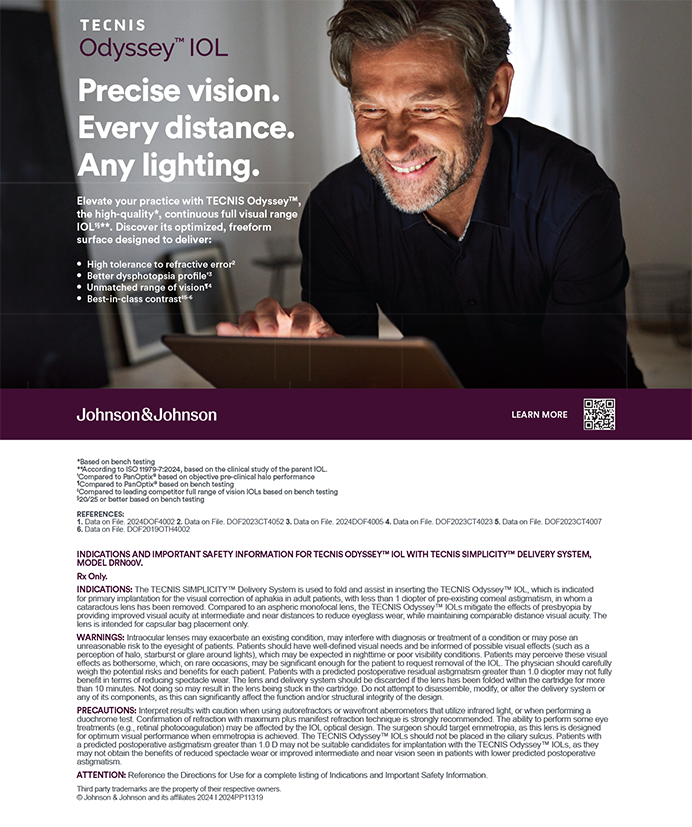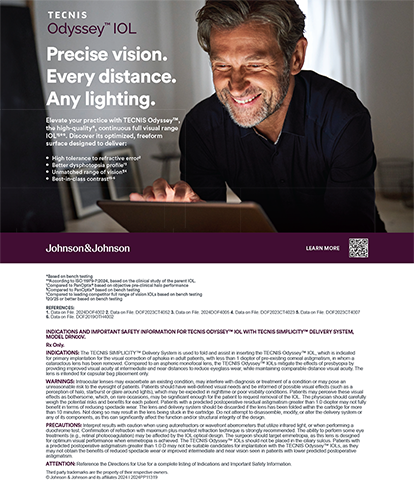Cover Stories | Jul 2005
The Brave New World of Refractive Cataract
A message to cataract surgeons who are going refractive.
Shareef Mahdavi
The most important governmental approval in ophthalmic medicine in recent times did not come from the FDA but from the Centers for Medicare and Medicaid Services (CMS) when it voted to dismantle a law that prevented consumers from making their own decisions about their eye care. Specifically, the CMS changed its rules to allow ophthalmologists to bill separately from cataract surgery for the implantation of presbyopia-correcting IOLs. Although a small army of dedicated individuals has worked for years to bring about such a change, few believed that the CMS would ever accept it.
In this column, I want to share some thoughts with those ophthalmologists who never embraced LASIK but now want to enter the world of “medical retail” by offering refractive implants. Culled from a dozen years of working on the laser side of refractive surgery are four areas for you to consider before taking the plunge.
EFFORT: IT WILL TAKE TIME
Ask any colleague who opened a laser center in 1995 or 1996, and he will tell you how difficult those early days were. There were a lot of lasers and too few patients willing to undergo treatment. Building procedural volume took increasing the availability of lasers across the country, training surgeons, broadening the available surgical options (eg, treatment for astigmatism and wavefront technology), and spreading the word about patients who had had successful outcomes. By mid-1998, the hard work of early-adopter surgeons to develop the market began to pay off in growing procedural volumes.
CHOICE: A DOUBLE-EDGED SWORD
That the government has now given consumers a choice is good news for surgeons. If patients want to pay more for a lens with more capabilities, they can. But, cataract surgeons need to take a lesson from LASIK surgeons, who learned the hard way that having too many surgical choices confuses patients and their decision-making process. Several years ago, offering tiered pricing for different technologies seemed like a good idea for stimulating demand because it allowed the consumer choices. In some categories, it works. I do enjoy choosing among the 17 different mustards available at the grocery store. But in other markets, tiered pricing backfires. Imagine your auto mechanic asking you which brand of carburetor you prefer. You wouldn't have a clue, and neither do most of your patients who seek eye surgery. They come to you for your expertise, and they expect you to understand their needs and help sort through all the choices for them rather than throw that responsibility in their laps. LASIK surgeons are learning this lesson, as many have used the introduction of new technology as an opportunity to consolidate their LASIK pricing into a single fee.
Likewise, because numerous technologies will be available for presbyopia, you need to think carefully about how you want to promote, educate, counsel, and manage patients with respect to all the choices out there.
PRICE: THINK LIKE A BANK
Price is one area where the discussion should be weighted much more toward the medical and less toward the retail side of the equation. A sizable portion of LASIK surgeons were led to believe that, if LASIK were a good thing, less expensive LASIK would be even better. In the year 2000, one in five LASIK providers charged an average fee of less than $1,000 per eye. Advertising for discount LASIK spread across all media. But, the market didn't grow. It shrank. The lesson: when it comes to their eyes, people want safety and quality, not a low price.
The way to solve the pricing conundrum is by focusing on affordability. This is true in any market that has an average purchase price of over $500. The solution is financing, which allows a consumer to borrow money and repay it in the future in exchange for making the purchasing decision today. With retail prices for a pair of refractive IOLs in the $8,000-to-$10,000 range (approximately double that of LASIK), patient financing becomes critical. Don't finance this cost yourself (note: you are a doctor, not a bank). There are several national vendors as well as local banks that specialize in this type of financing. Look for a vendor that will consistently finance the entire amount, do it with minimal hassle, approve a high percentage of applications, and charge a reasonable interest rate to the patient as well as a discounted rate to the practice. Expect to pay 4% to 5% to the vendor to handle the loan, which should have an interest rate of less than 10% based on current consumer loan rates. You will pay more if you want to offer a 0% interest rate (which has worked well in LASIK). In return, you should see at least 70% of your patients' applications approved with minimal headache and hassle.
EXPECTATIONS: MANAGE THEM CAREFULLY
With these high price tags, patients seeking IOL-based refractive surgery will have sky-high expectations. Managing expectations becomes a critical skill for you as a surgeon, especially now that the transaction is direct between payor and provider. Resist the temptation to promise more than you or the technology can deliver, especially when we are knocking on the door of future presbyopic solutions. Overpromising and underdelivering will disappoint your patients, even if their clinical results are excellent, and can kill customer satisfaction and all the future business those referrals would have generated. Instead, set the bar a bit lower for your patients and let them be thrilled with their new vision. Warning: set it too low, and no one will sign up. Thus, properly managing expectations is a delicate balancing act.
IN CLOSING
Many years from now, I think we will look back and see that spring 2005 was a major turning point in ophthalmology. A free market for IOLs increases the incentive for manufacturers and providers to develop new ways to improve vision. Keep in mind that the free market is far from being without cost. It will take tremendous effort at the provider level to create consumer acceptance for these new procedures. Hopefully, we can build on what we have learned over the past decade and create a bigger and brighter future for all of refractive surgery and the millions of patients out there who need it.
Shareef Mahdavi draws on 20 years of medical device marketing experience to help companies and providers become more effective and creative in their marketing and sales efforts. Mr. Mahdavi welcomes comments at (925) 425-9963 or shareef@sm2consulting.com. Archives of his monthly column may be found at www.crstoday.com.


